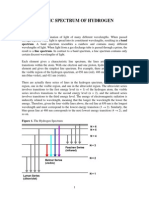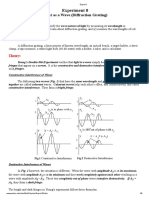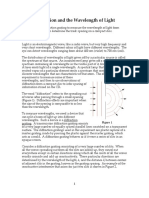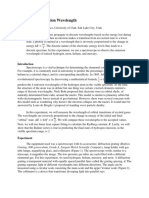Lab 13: Atomic spectra
Equipment:
Laser pointers of three different colors (red, green, purple), Diffraction gratings with holder (three different
kinds glass or polaroid), black Pasco 1.2 m track, ruler, black screen, Spectrum Tube Power Supply, Spectrum
tube -Hydrogen, Mercury, Excel Spreadsheet.
Theory:
Atomic spectra is a “finger-print” for each element identification because different nuclear charge (+Z) and
number of electrons in electron cloud lead to different arrangements of the energy levels. When gasses made of
certain type of atom are heated in the spectrum tube, they produce different types of photons (colors of light)
because of those different energy levels transitions.
According to the Bohr’s quantum theory, electrons energy is quantized and for a hydrogen atom can be
calculated as:
−13.6 eV
En = 2 (Eq. 1)
n
where n is a principle quantum number that can take values = 0, 1, 2, 3, …, and En is a value of energy of the
n-th energy level in eV.
Emission of the photon occurs when electron transitions from higher to lower energy level.
Δ E=¿ (Eq. 2)
where h=6.63 x10-34Js and c=2.99 x 108 m/s , the Planck’s constant and the speed of the light, respectively.
Energy of the photon can be equal only to the difference of the energy levels and that leads to formation of the
spectral lines with distinct wavelengths, , present in the spectrum of the hydrogen spectral tube. Since we will
be using our eye as detector, we will be only able to detect spectral lines in the visible part of the spectrum that
all have same Enf = E2.
A diffraction grating uses interference to separate the light according to wavelength. Constructive and
destructive interference is exhibited by all types of waves including visible light. When the waves from two
separate sources interact, they either add to increase the intensity or they cancel each other out. Condition for
the constructive interference can be written as:
s = r2 – r1 = n (Eq. 3)
where s is part difference between two light waves produced by sources, n is the integer number of
wavelengths.
Based on the Figure 1 triangle ABD,
s = d sin = n (Eq. 4)
where d is the distance between two slits on the diffraction
grating. So to find value of d we should determine angle .
Tringle ABD is congruent with triangle ECP so angle is
the same for both right triangles.
Based on the figure 1 triangle ECD, tan = y/L where y is
distance between central maximum of diffraction pattern
and n – th side maximum and L is distance from diffraction
grating and the screen. By measuring y and L we can
Figure 1. determine angle using equation =tan-1(y/L) and by
substituting in Eq. 4 solve for d.
Prelab questions:
� 1. Convert 13.6 eV to Joules. Show your work.
13.6 eV * (1.60*10^-19 J) = 2.176*10^-18 J
2. Rewrite Eq 1 from previous page using E in Joules.
−18
−2.176∗10 J
En = 2
n
3. Use Eq 2 to predict wavelengths for 3 visible lines in the spectrum of hydrogen atom by filling the table
below.
Table 1.
Transition (E¿¿ nf )lower ¿ (E¿¿ nf )higher [J ]¿| Δ E∨[J ] Predicted Predicted Approximate
ni nf [J] [m] [nm] color
32 -5.44*10^-19 -2.41*10^-19 3.03*10^- 6.56*10^- 656 red
19 7
42 -5.44*10^-19 -1.36*10^-19 4.08*10^- 4.88*10^- 488 blue
19 7
52 -5.44*10^-19 -8.704*10^- 4.57*10^- 4.35*10^- 435 violet
20 19 7
62 -5.44*10^-19 -6.04*10^-20 4.84*10^- 4.11*10^- 411 violet
19 7
72 -5.44*10^-19 -4.44*10^-20 4.996*10^- 3.98*10^- 398 violet
19 7
4. Convert wavelength of the green laser (532 nm) to meters.
- 5.32*10^-7 m
5. If a wavelength of the laser pointer is recorder like 730nm 10nm, what does that mean?
- It means that it can be plus or minus 730 nm it can be greater or less than it can be a standard
error.
Part A: Determinizing the distance between two lines on the diffraction grating
1. Record the wavelength of the used laser pointer as indicate on the pointer sticker: __650
nm___________
2. Set up the laser, diffraction grating and black screen on a Pasco Track as illustrated. You can increase
height of laser pointer or diffraction gating with a wooden block available in the cabinet so that they are
aligned.
�2. The Distance L will be the distance from the black screen to the front edge of the diffraction grating. Set
the black screen to the distance Li such that central maximum and only 2 side maximums (both with n=1)
are visible on the screen, like the photo bellow.
Central maximum
n=1 maximum n=1 maximum
3. Record the position of the screen and diffraction grating in the table below. Calculate L.
4. Without disturbing position of the black screen, use push pins to mark position of central maximum and
two side maximums (left and right).
5. Y is the distance measured to the first maximum away from the central maximum. Move the grating to
produce 5 different values of Y. Pay attention that central maximum always falls in the same position
marked by the central pin and use pins to mark each new set of n=1 maximums.
6. Once all 11 pins have been placed on the screen, put screen down on the table and use ruler to measure
Yleft and Yright for each of 5 different L.
7. Record data in the table below.
Table 2.
Position if diffraction Position of L= xs -xdg Yleft Yright Yaverage = (Yleft + Yright)/2
grating xdg[cm] screen xs [cm] [cm] [cm] [cm] [cm]
0 80 cm 80 cm 30.3 27.0 28.65 cm
cm cm
0 65 cm 65 cm 24.6 22 cm 23.3 cm
cm
0 72 cm 72 cm 24.5 26.9 25.7 cm
cm cm
0 52 cm 52 cm 18.6 19.0 18.8 cm
cm cm
0 88 cm 88 cm 31 31.3 31.15 cm
cm cm
8. Graph Y vs. L, and find the slope of the line, which will be Y/L. But since Y/L is the tangent of the
angle that the laser light makes at the first maximum, set the slope of the line equal to the tan () and solve
for .
a. Copy/Paste finished graph.
� Y average vs L (cm)
35
30 f(x) = 0.345490093847758 x + 0.852007299270078
R² = 0.999591807661432
Y average (cm) 25
20
15
10
0
50 55 60 65 70 75 80 85 90
L (cm)
b. Write the equation of the linear trend line:
y = 0.3455x + 0.852
c. Calculate =_19.1____________. Show your calculation.
tan^-1 (0.3455) = 19.1 degrees
9. Use calculated to determine distance between two slits on diffraction grating you used. Show your
calculation. d = 1(6.50x10^-7 m) = 1.98*10^-6 m
sin (19.1)
10. Value of d=__1.98*10^-6 m_______________ will be used in the Parts B and C of the lab.
Convert distance d to number of lines per mm and compare with the value indicated on the assigned
diffraction grating.
1.98*10^-6m / (1*10^-3 mm) = (0.00198)^-1 = 505.05 lines/mm
Part B: Hydrogen atom spectrum
1. Replace laser pointer with hydrogen spectrum tube placed in power supply.
2. CALL INSTRUCTOR TO HELP YOU with this step. Switch the power on and mask everything but short
thin part in the middle of the tube. BE CAREFULL -Power supply produces HIGH VOLTAGE – do not
touch EXPOSED METAL PARTS of the spectral tube.
3. Adjust the height of the diffraction grating so that light from unmasked part of the tube shine directly on it.
4. Remove all push pins from the black screen and return screen in upward position.
5. Record distance from the diffraction grating to screen, L = __67.7 ___________________ cm.
6. Sketch spectrum and clearly label color of each line.
Hydrogen
7. Use push pins to label positions of central white maximum and first order maximums for all visible spectral
lines.
�8. Once all 7 pins have been placed on the screen, put screen down on the table and use ruler to measure Y left
and Yright for each of 3 different spectral lines visible in spectrum of H.
9. Record measurement in the table below.
Table 3.
Color of the Yleft Yright Yaverage = (Yleft + Measured Predicted
% difference
spectral line [cm] [cm] Yright)/2 [cm] [m] [m]
13.6 15.2 14.4 cm 4.21*10^-7 m 4.35*10^-7
Violet cm 3.27%
cm m
16.2 16.8 16.5 cm 4.82*10^-7 m 4.88*10^-7
Blue 1.23%
cm cm
21.7 24.0 22.85 cm 6.68*10^-7 m 6.56*10^-7
Red 1.81%
cm cm
Y nλ
10. Calculate measured using equation or fringe spacing: = applied on the first order maximums.
L d
11. Identify transitions that produced those lines and copy predicted values of from Table 1.
12. Calculate % difference between measured and predicted wavelength and add to table 3.
Analysis:
1. Compare the measured lines to the known lines.
They are pretty much the same.
2. What is formula for the relationship between wavelength and photon energy? __E =
hc/____________
3. If only certain wavelengths are produced, what does that mean about the photon
energies? _Photon energy is dependent on the wavelength and are inversely
proportional.____________________________
4. What does that mean about the electron energies for Hydrogen? ___There are no
photons of the wavelength, so not all photon energies are created and they aren’t
discrete and energy levels have to be
discrete._____________________________________________
















































































